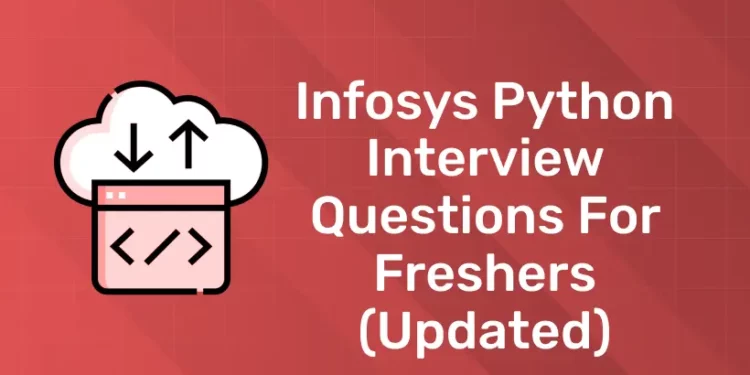Table of Contents
Infosys is a multinational IT consulting firm that offers comprehensive solutions in the fields of business consulting, information technology, and outsourcing services, helping customers from different industry sectors to improve their company performance. For businesses in the manufacturing, insurance, finance, and other industries, Infosys primarily provides software development, product maintenance, and independent validation services.
Experience the power of our python programming course with a free demo – enroll now!
Introduction
Formerly known as Infosys Technologies Ltd., Infosys was founded in 1981. Along with six other engineers, N. R. Narayana Murthy created Infosys in Pune. Merely US$250 was the first capital investment used to launch the company. Bangalore, India currently serves as Infosys’s headquarters.
Infosys assists customers in more than 50 nations in developing and implementing various strategies for their digital transformation process. Infosys leads its clients’ transformation into a smarter organisation in addition to assisting them in improving their overall business performance. As a result, its clients are able to concentrate on their main business responsibilities.
Why Infosys
Infosys has experience in a number of sectors. Infosys delivers incredibly potent, cutting-edge products and services, from assisting in the development of lighter, stronger passenger jets. And more fuel-efficient smart cars to enabling banks to provide financial inclusion to the world’s most remote regions and assisting technology professionals with solutions to maximise their global reach. Infosys transforms the way people live and work in the world through this exacting procedure.
At Infosys, stakeholder confidence is gained via more than simply innovation. They think that their duties go beyond what is required of them in the commercial world. Under the banner of corporate social responsibility, the Infosys Foundation assists some of the most destitute segments of the communities in which they operate.
Career Options for Python in Infosys
Python is a flexible programming language that is widely utilised in many different fields. Infosys, a leader in technology services and consulting worldwide, provides a wide range of job options for Python fans. Knowing the career pathways offered by Infosys will help you navigate and organise your professional journey more successfully, whether you’re just starting out or hoping to develop in your career.
Roles for Python Professionals at Infosys
Software Developer/Engineer:
- Role: Utilising Python and related technologies, develop and maintain software applications.
- Skills: Knowledge of software development procedures, familiarity with frameworks such as Flask and Django, and proficiency with Python.
- Designing, coding, testing, and debugging software programmes are among the responsibilities.
Data Scientist/Analyst:
- Role: Use Python and programmes like NumPy, Pandas, and scikit-learn to analyse large, complicated data sets.
- Proficiency in statistical analysis, machine learning, data manipulation, and strong Python programming abilities.
- Duties include data mining, predictive modelling, and drawing conclusions from huge databases.
Quality Assurance/ Test Engineer:
- Role: Use Python to create automated test scripts for software quality control.
- Skills: programming in Python, familiarity with testing frameworks such as pytest or unittest, and comprehension of quality assurance procedures.
- Writing test cases, carrying out tests, and guaranteeing software quality are among the responsibilities.
DevOps Engineer:
- Role: Use Python scripting to automate and streamline procedures.
- Skills: scripting in Python; familiarity with DevOps tools such as CI/CD pipelines, Docker, and Kubernetes.
- Deployment automation, continuous integration/delivery, and infrastructure as code are the responsibilities.
Cloud Engineer:
- Role: Use Python for automation to manage and launch apps on cloud platforms.
- Competencies include infrastructure management, cloud computing platforms like AWS, Azure, or GCP, and Python scripting.
- Setup, maintenance, and optimisation of cloud infrastructure are among the responsibilities.
Cybersecurity Analyst:
- Role: Use Python for security automation to analyse and improve system security.
- Skills: Knowledge of cybersecurity, proficiency with Python scripting, and comprehension of security tools.
- Threat identification, incident response, and vulnerability assessment are among the responsibilities.
Growth Opportunities
Infosys provides lots of chances for skill development and career advancement through:
- Training Programmes: Python and related technology training programmes promote lifelong learning and upskilling.
- Certifications: Possibilities to become certified in Python and other pertinent fields.
- Leadership Positions: Routes to positions including project management and team leadership.
Infosys Interview Process
1. Interview Process
- Online Test
- Technical Interview
- HR Interview
There is no change in the recruitment procedure for individuals with experience. However, for certain crucial positions, you would need to show up for two or more rounds of technical interviews, which would be followed by an HR interview.
2. Interview Rounds
1.Online Test:
There are three portions to the online assessment test, and each has time constraints and cutoffs. The online assessment test is divided into three sections:
- Logical and Analytical Reasoning: This part includes easy to moderately difficult questions on data sufficiency, data interpretation, syllogism, visual reasoning, and statement reasoning, among other topics.
- Quantitative Aptitude: This section includes questions ranging in complexity from moderate to high. Topics include time, permutation and combination, speed and distance, number series, analytical puzzles, formulas, algebra, probability, and more.
- Verbal Ability: Synonyms, antonyms, fill-in-the-blanks, sentence correction, paragraph completion, vocabulary, etc. are all expected in this round.
Depending on the results of the interviews, the number of questions and time allotted for the aforementioned areas in this round may change.
2. Technical Interview:
A technical interview will be scheduled for you if you pass the online assessment exam. The questions that are asked of the candidates in this round typically centre on their resumes and areas of interest.
In this round, a strong understanding of computer principles such as operating systems, data structures, and algorithms, as well as familiarity with the newest developing technologies, are expected of you. Additionally, you should be proficient in at least one programming language.
You must decide on and get ready for a field of interest that is directly relevant to the position. In certain rounds, such as aptitude tests and puzzles, your ability to solve problems will also be evaluated. Additionally, be prepared to respond to inquiries about your projects, internships, and the part you played in them.
3.HR Interview:
If you pass the technical interview, you’ll be invited to the HR interview stage. Basically, the goal is to determine if you are the most suitable candidate for the organisation. We’ll be asking you about a lot of things here, such your background, schooling, interests, and even your outlook on life.
There will be questions about the Infosys company, so be ready for them. Additionally, be prepared to answer any inquiries meant to gauge your seriousness in applying for the position.
Infosys Interview Questions for Freshers in Python
Q. What do you meant by PYTHONPATH?
Answer: Python has an environment option called PYTHONPATH that allows users to specify additional directories that Python should look through for modules and packages. This variable helps Python find the files it needs to import when running code by acting as a search path.
Users can alter the module search behaviour to suit their needs and extend the default search path by configuring the PYTHONPATH variable. With the help of this functionality, developers can neatly structure and organise their Python projects, making it simpler to import modules and improving code reuse.
Q. What are the differences between modules and libraries?
Answer: Modules in Python are akin to stand-alone files that contain particular code elements like variables and functions. However, libraries are just enormous collections of modules that include pre-built features and tools designed for particular tasks or domains. These libraries improve Python’s capabilities and make development easier by offering ready-made solutions for a range of programming problems.
Q. How to install Python on Windows and set a path variable?
Answer: The following instructions can be used to install Python on Windows and set a path variable:
Download Python:
- Go to www.python.org, the official Python website.
- Select the tab labelled “Downloads.”
- Select the most recent Python version for Windows.
- Choose the installation that is compatible with your system (32- or 64-bit).
Run the Installer:
- Click the installer twice after downloading it.
- During the installation procedure, check the “Add Python to PATH” box.
- If you would like to change the installation location or any of the components, select “Customise installation.”
Set the Path Variable:
- Look up “Environment Variables” or “Edit the system environment variables” in the Start menu when it has opened.
- The “Environment Variables” button should be clicked.
- Click “Edit” after locating the “Path” variable under “System Variables.”
- After choosing “New,” enter the directory location where you installed Python.
- Usually, you can find it in “C:PythonXX,” where XX stands for the Python version number.
- To save the changes, click “OK.”
Verify the Installation:
- A new Command Prompt window should open.
- Hit Enter after typing “python.”
- You should see the Python interpreter prompt with the version information if Python has been installed correctly.
Q. What is the difference between loc and iloc?
Answer: The Pandas package in Python has two functions, loc and iloc, to access various regions of a DataFrame. The main purpose of them is to choose rows and columns.
| loc | iloc | |
| Indexing Type | Label-based | Position-based integer |
| Input | Data accepts row and column labels | Accepts row and column locations as integers |
| Slicing | The range includes the end label | End position is the range’s unique position. |
| Subsetting | Able to pick rows with a specific label and condition | Able to choose rows based on integer places irrespective of the DataFrame index |
| Mixed Selection | Permits the use of labels in both columns and rows | Employs integer locations for columns and rows. |
| Callable | Callable functions are supported | Supports callable functions as well. |
Q. What do you understand by iterators in Python?
Answer: One at a time access to a collection’s elements is possible with Python iterators. Until there are none left, they obtain the subsequent element using the __iter__() and __next__() methods. Iterators can be made for custom objects and are frequently used in loops. They facilitate sluggish element evaluation and encourage effective memory use. In conclusion, iterators offer a practical means of efficiently and controllably iterating across data structures.
Q. Explain the use of ternary operators in Python?
Answer: In Python, the operator that displays conditional expressions is called the ternary operator. This is made up of a statement that needs to be verified and boolean true or false values.
[code] x, y=10,20 count = x if x < y else y JustificationThe evaluation of the phrase count = x if x < y otherwise y is as follows:The value of x is allocated to count if the condition x < y is true. This indicates that the count will equal x if the value of x is smaller than the value of y.
The value of y is assigned to count if the condition x < y is false. This indicates that the ecount will equal y if the value of x is not smaller than the value of y.
Q. How will you reverse a list in Python?
Answer: Python’s slicing mechanism can be used to reverse a list. Here’s a quick rundown of the procedure:
If you want to reverse a list, start with the original list.
To make a new list with every entry from the old list in reverse order, use the slicing syntax [::-1].
Either overwrite the original list with the reversed version or assign the reversed list to a new variable.
[1, 2, 3, 4, 5] is the original_list.list_reversed = list_original[::-1]
Experience the power of our python programming course with a free demo – enroll now!
Q. Explain about generators in Python?
Answer: Python generators are unique functions that let you make iterable objects. Generators employ the yield keyword to halt execution momentarily and yield values one at a time, in contrast to normal functions that return a value and then exit. Because they only produce values as needed rather than the full series of values at once, this makes generators memory efficient.
When working with enormous datasets or when the entire value sequence is not required at once, generators come in handy. They spare us from using up too much memory by enabling us to loop over an essentially limitless sequence.
Q. Explain the difference between pickling and unpickling?
Answer: The Python object is accepted by the Pickle module, which uses the dump method to transform it into a string representation and save it to a file. We call this process pickling. Conversely, unpickling is the act of obtaining the original Python objects from the textual representation.
Q. What is the difference between %, /, // ?
Answer: The arithmetic operators %, /, and // have different functions in Python:
- The modulo operator, represented by the symbol %, yields the remainder of a division. For example, 5% 2 would yield 1.
- The division operator that divides using floating points and returns a float is ‘/’. For instance, 5 / 2 would provide 2.5.
- The floor division operator, represented by the symbol //, divides the result but rounds it down to the closest whole number. Thus, 5 / 2 would yield 2.
Q. Describe the split(), sub(), and subn() methods found within Python’s ‘re’ module?
Answer: These functions are used to alter strings and are part of the Python RegEx, or “re,” package.
- split(): This function divides a supplied string into a list.
- sub(): This function replaces the matched substring with an alternate string after determining which substring a regex pattern matches.
- subn(): This function returns the new string plus the number of replacements; otherwise, it functions similarly to sub().
Q. What is a map function in Python?
Answer: Method and iterable are the two parameters used by Python’s map() method. One useful tool that lets you apply a function to each element in an iterable is the map() function. It requires two arguments: an iterable containing the elements you wish to process and the function you wish to apply. With the help of this function, you can work on several objects at once in a flexible manner, which will improve the efficiency and clarity of your code.
For example:
def calculateSq(x):return x*xnumbers = (5, 6, 7, 8)result = map( calculateSq, numbers) |
Q. Differentiate between a package and a module in python.
- Make a directory and give it a meaningful name that accurately describes how it works.
- Make a file called __init__.py in this directory. Python is informed that the directory we made is a package thanks to this. To repurpose the functionality, its contents can be imported into various modules in other packages.
Q. What are some of the most commonly used built-in modules in Python?
- os
- math
- sys
- random
- re
- datetime
- JSON
Q. What are lambda functions?
mul_func = lambda a,b : a*b
print(mul_func(5, 3))
# Output: 15Frequently Asked Questions
1: Which of the following data types is immutable in Python?










![Best Software Testing Resume for Freshers [ Experts Guide ]](https://entri.app/blog/wp-content/uploads/2024/05/Best-Software-Testing-Resume-for-Freshers-Experts-Guide--75x75.png)
